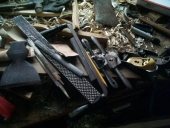Peter Ellis wrote:
You want clear wood with as straight a grain as possible for making axe handles. That's one thing. You want to saw the kerf for your wedges. Driving a chisel into end grain is a splitting technique, you will split your handle doing that. Your wedge wants to push the handle against the sides of the axe eye, not the ends, so make your cut for your wedge in line with the axe edge, not perpendicular to it. You get much more are for pressure and friction pushing the sides out rather than the front and back. Use hardwood wedges the length of your axe eye front to back and make them three quarters the depth of the axe eye. Cut the kerf just a little deeper than the wedge is long.
...
The other thing that was very apparent in watching your video is that all of your tools are seriously in need of proper sharpening. Not intending to be insulting, trying to help you improve your work and avoid injuring yourself. The kind of force you were using with that huge drawknife (I've never seen one with a blade that deep before) is difficult to control and that becomes dangerous. A drawknife should be razor sharp, able to easily shave paper thin curls off of a piece of wood. Same for chisels. Sharp is safe, dull is dangerous. Again, control is the key to safety, and sharp tools are much easier to control, because you can do the task with much less force.
I agree straight grain would be ideal for straight handles, though I think curved grain that matches the curve of a curved handle would be ideal in that situation. Traditionally, kerfs were split. Maybe it was because early on people were much more likely to have a knife or chisel than a saw, but it continued far into the times when saws had been perfected. I imagine they started being sawn pretty exclusively after handles were mass produced from sawn boards, and the grain was not as carefully oriented as a hand-made handle. In any case, a split kerf will follow the grain exactly and the wedge cannot bottom out. I like to sharpen the wedge to a feather edge, and in my mind's eye I picture the fibers of the wedge intermingling with the fibers of the handle, helping to hold the wedge in place.
Traditionally, a kerf is not always made lengthwise across the head. I'm not too familiar with Japanese tools, but I have seen many new hatchets of the variety pictured with actually no kerf at all, and a removable steel wedge driven between the handle and head, oriented cheek to cheek. The Japanese heads' eyes will likely not have a taper made conducive to being wedged the way you describe. I also wonder if, since they were made to be wedged cross wise, it would be much more likely to accidentally split the welds if a wedge were driven in line with the head. Western heads tended to have more substantial polls and rounded eyes. Even some western tools had crosswise kerfs. I recall from some old ads for claw hammers that there was apparently stiff competition between companies to see who could claim to have the most solid system. Some of those involved two or three wedges, some driven crosswise.
I may use a hard wedge if the handle is a relatively soft wood, but I've found that hard wedges in hard wood don't want to stay put. I feel they are also much more likely to break the eye of the axe head. With a soft wood and a hard wood driven together, the softer wood can compress. I think this is also more likely to allow the joint to stay tight in varying weather conditions, because the compressed softer wood acts like a spring and can compensate for slight variations in size. My favorite wood for wedges is typically quarter-sawn pine. The softer fast growth rings are very compressive, and the harder slow growth rings are much tougher and have rosin in them, helping the wedge to bite into the wood and hold. I love Buckin' Billy Ray (who couldn't?), but I believe he glues in his wedges, which I never do. If the head loosens, what are you going to do? Very possibly be making a new handle, because you can't get the wedge out without drilling, and they don't make wedge-shaped drill bits for some reason, lol. I do sometimes use rosin. It provides friction without the permanence of glue (and it's all natural). You also won't see me driving those steel wedges in to hold the wooden wedge in place. If you've ever removed one, you'll know what I mean. If I have a wedge that is suspect, due to a rather obtuse angle or something, I drill a pilot hole through the wedge and handle and install a screw with a countersunk head. A screw can easily be removed.
As for the sharpness of the tools, I think he's demonstrated he knows a thing or two about sharpening from his other projects. Truly hard woods can be a bear to work no matter how sharp things are. Historically, draw knives were not intended for removing paper thin shavings, but for hogging off large amounts of wood in a hurry. For the finer work, they would normally have put down the draw knife for a spokeshave, or something more appropriate. Western drawknives also could have straight handles or double bevels. There was always more than one way to skin a cat, apparently.


 4
4
















 4
4
















 2
2














 1
1




 1
1

















 2
2












 1
1





 1
1
























